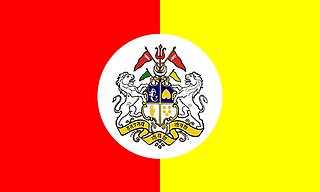Related Research Articles

The Tripuri are an ethnic group originating in the Indian state of Tripura. They are the original inhabitants of the Twipra/Tripura Kingdom in North-East India and Bangladesh. The Tripuri people through the Manikya dynasty ruled the Kingdom of Tripura for many years until the kingdom joined the Indian Union on 15 October 1949.
Kokborok(Tiprakok/Tripuri) is the native language of Tripuri people in present Tripura state in North East of India. During 20th centuries many of Royal family and its officials contributes to develop the Kokborok Language in many ways.

The Manikya dynasty was the ruling house of the Twipra Kingdom and later the princely Tripura State, what is now the Indian state of Tripura. Ruling since the early 15th century, the dynasty at its height controlled a large swathe of the north-east of the Indian subcontinent. After coming under British influence, it had lost some parts of kingdom present "Cumilla" and "Chittagong Hill Tracts" in Bangladesh.

Tripura State, also known as Hill Tipperah, was a princely state in India during the period of the British Raj and for some two years after the departure of the British. Its rulers belonged to the Manikya dynasty and until August 1947 the state was in a subsidiary alliance, from which it was released by the Indian Independence Act 1947. The state acceded to the newly independent Indian Union on 13 August 1947, and subsequently merged into the Indian Union in October 1949.
Pratap Manikya was a Maharaja of Tripura during the late 15th century.
Dharma Manikya I, also known as Dangar Fa, was the Maharaja of Tripura from 1431 to 1462. His reign was notable for its territorial expansions as well as for his religious and cultural contributions.
Maha Manikya, also known as Chhengthung Fa, was the Maharaja of Tripura from about 1400 to 1431. Contrary to narratives provided by early histories, evidence indicates that Maha Manikya was the founder of the kingdom, having established dominance over neighbouring tribes in the early 15th century. He is further thought to be the first holder of the title "Manikya", taken in recognition of a historic victory over the neighbouring Bengal Sultanate. The dynasty which he founded continued using the title until Tripura's merger with India in 1949.
Yashodhar Manikya, also known as Jashodhar Manikya, was the Maharaja of Tripura from 1600 to 1618. His reign is considered to be the nadir of the kingdom's history, with the temporary overthrowing of the monarchy and the region's incorporation into the Mughal Empire.
Kalyan Manikya was the Maharaja of Tripura from 1626 to 1660. Reigning in the aftermath of an occupation by the Mughal Empire, Kalyan did much to restore the kingdom, though it remained in a continuous state of war with the Mughals.
Govinda Manikya was the Maharaja of Tripura from 1660 to 1661 and again from 1667 to 1676. Though viewed as a capable and successful ruler, Govinda's reign was interrupted by his temporary overthrow and usurpation by his younger brother.
Rama Manikya, also called Ram Manikya or Ramdev Manikya, was the Maharaja of Tripura from 1676 to 1685.
Vijaya Manikya II, also spelt Vijay or Bijoy, was the Maharaja of Tripura from 1532 to 1563. Succeeding to the throne at a young age, Vijaya proved himself to be a formidable military leader, initiating a series of conquests into several surrounding kingdoms, including the powerful Bengal Sultanate. During Vijaya's reign, the might and influence of Tripura reached its zenith, leading to him being viewed as one of its greatest monarchs.
Lakshman Manikya was the Maharaja of Tripura during the mid-18th-century, though he maintained little actual power, having acted only as a puppet-monarch under Shamsher Gazi.

The Chaturdasa Devata or Fourteen Gods is the Shaivite Hindu pantheon worshipped in the Indian state of Tripura.
Narendra Manikya was the Maharaja of Tripura from 1693 to 1695.
Mukunda Manikya was the Maharaja of Tripura from 1729 to 1739.
Rajdhar Manikya I, also spelt Rajadhara Manikya, was the Maharaja of Tripura from 1586 to 1600. Formerly a warrior-prince who fought with distinction during his father's reign, upon his own ascension to the throne, Rajdhar showed little interest in such matters, instead becoming occupied with religious pursuits. The decline of Tripura is thought to have begun during his reign.
Joy Manikya II was the Maharaja of Tripura during the mid-18th-century. He originally gained the throne through popular approval for his military hostility to the Mughal Empire. However, Joy spent much of his reign warring against various relations to maintain his grip on it, in particular with his cousin Indra Manikya II.
Indra Manikya II was the Maharaja of Tripura during the mid-18th-century. His reign was spent struggling for control of the kingdom with his relative Joy Manikya II.
Udai Manikya II was the Maharaja of Tripura briefly during the mid-18th-century, having laid claim to the throne during a power struggle between his relatives Joy Manikya II and Indra Manikya II.
References
- ↑ Chib (1988), p. 13.
- ↑ Durlabhendra, Sukheshwar & Baneshwar (1999), p. 169.
- ↑ Sarma (1987), p. 122.
- ↑ Sarma (1987), p. 130.
- ↑ Durlabhendra, Sukheshwar & Baneshwar (1999), p. 176.
- ↑ DebBarma (2006), pp. 24–25.
- ↑ Kilikdar (1995), pp. 54–55.